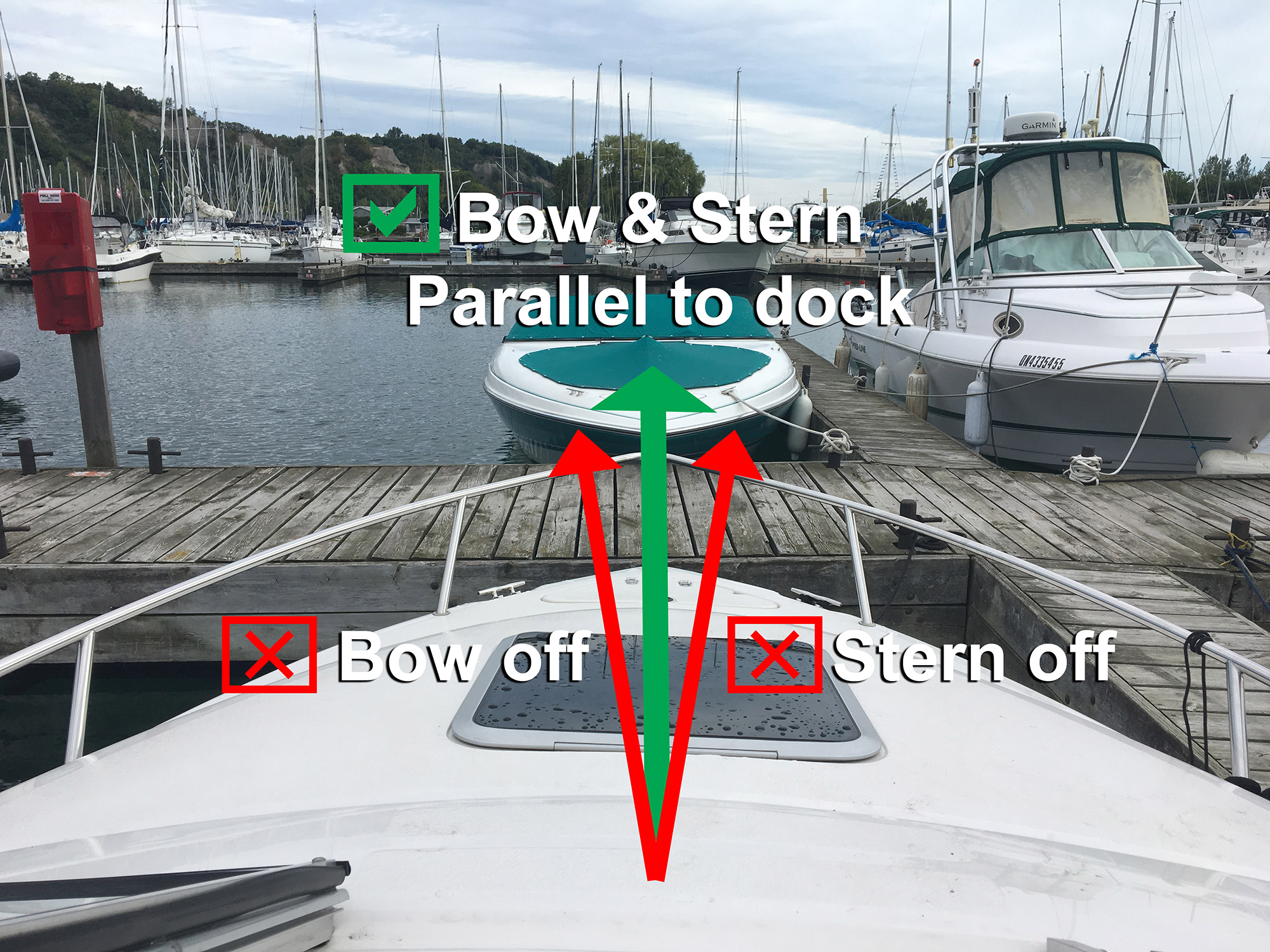How to avoid it and dock better
How often have you had everything lined up perfectly on a final approach to the dock only to lose it at the last moment? If the bow got away on you, it may have been the result of over-steering and not the wind, as some may think. The thing about over-steering during docking maneuvers is it often goes unnoticed until its too late and you aren’t lined up correctly.
Over-steering often occurs when we turn our full attention away from the bow following a turn (or a twist, as I like to call it) and don’t realize the bow is still turning. Since docking is a step-by-step process, its important to always be paying attention to both ends of the boat during (and after) each and every step.
But before we take a closer look at this, let’s first re-visit the basics of side-on docking for single engine boats:
- Approach on an angle using the shift and drift technique to control speed
- Turn parallel a few feet off the dock with a wheel turn and short shift
- A final short shift (or two) to stop parallel along side.
- Number two on this list is where things often go wrong. When we throw in a turn as part of our docking maneuvers, its important to stop the turn before moving on to the next step.
- A bow in motion may stay in motion
A power boat’s bow is lighter than its stern and this makes it susceptible to carrying momentum through a turn longer than you may have expected. Far too often, I see skippers at the helm with the mindset of driving a car and too much power is being used. Too much power can quickly generate too much momentum. I like to emphasise the importance of slowing things down when docking a boat, avoid using power if it isn’t needed, and to stop any turning motion before attempting to come straight in.
Stopping the turning motion: single engine boats
There are two easy methods to choose from when taking the turn out of the bow on a single engine boat:
- Shift to neutral early and centre the wheel to allow the turn to decay naturally.
- Use a short shift with the wheel turned in the opposite direction to counter the turning motion. Do not stay in gear any longer than it takes to stop the turn.
Bow control for bow-in docking
Most slips require that we make a turn before we come into the slip. Again, it is important to take the turn out of the bow before committing all the way in. It can help to have something at the back of the slip to line up on, such as a power pedestal or cleat. Don’t let the bow turn past it as you come to a stop.
Bow control for stern-in docking
Stern-in approaches typically require that you stop in front of your open slip and begin a standing turn until you have the angle to come straight in. Before reversing in, take a quick look to the bow and be certain to stop any turning action up front before backing up.
Final thoughts on over-steering
Don’t forget to maintain a 360-degree awareness of what is happening during your maneuvers and know whether the bow (or stern) is still turning after you have achieved the desired angle of approach. If it is drifting, make the correction to stop the turn before attempting a straight-line in. As always, know when to abort and try again.
Keyword : best boat, Best boat buying website, best boat marina website, best boat travel website, best place to rent a boat, boat accessories, boat angler, boat boondocking, boat buyers guide, boat camper, boat camping, boat dealers, boat DIY, boat Fishing, boat Fixer, boat handling, boat Home, boat information, boat insurance, Boat Maintenance, boat marinas, boat marinas in Alberta, boat marinas in BC, boat marinas in Canada, boat marinas in Manitoba, boat marinas in Saskatchewan, boat marinas in the USA, boat marinas near me, boat products, boat rentals, boat repair, boat road test, boat sharing, boat sites near me, boat supplies, boat Tech, boat tips, boat touring, boat trade, boat Travel, boat traveling, boat travelling, boat vacation, boat vacation cost, boat websites Canada, boating Canada, Boating Canada’s Boat Lifestyle Magazine, Boating Lifestyle Magazine, boating website, Canadian marina websites, expert boat information, find a boat dealer, how much does a boat cost, how much does marina cost, how to choose a boat, how to drive a boat, marina products, marina supplies, motor boat, power boating magazine, top boat website, used boat reviews best boat, Best boat buying website, best boat marina website, best boat travel website, best place to rent a boat, boat accessories, boat angler, boat boondocking, boat buyers guide, boat camper, boat camping, boat dealers, boat DIY, boat Fishing, boat Fixer, boat handling, boat Home, boat information, boat insurance, Boat Maintenance, boat marinas, boat marinas in Alberta, boat marinas in BC, boat marinas in Canada, boat marinas in Manitoba, boat marinas in Saskatchewan, boat marinas in the USA, boat marinas near me, boat products, boat rentals, boat repair, boat road test, boat sharing, boat sites near me, boat supplies, boat Tech, boat tips, boat touring, boat trade, boat Travel, boat traveling, boat travelling, boat vacation, boat vacation cost, boat websites Canada, boating Canada, Boating Canada’s Boat Lifestyle Magazine, Boating Lifestyle Magazine, boating website, Canadian marina websites, expert boat information, find a boat dealer, how much does a boat cost, how much does marina cost, how to choose a boat, how to drive a boat, marina products, marina supplies, motor boat, power boating magazine, top boat website, used boat reviews
